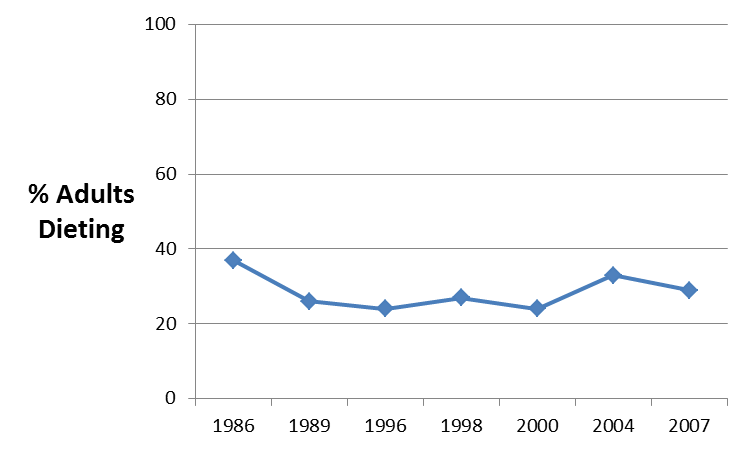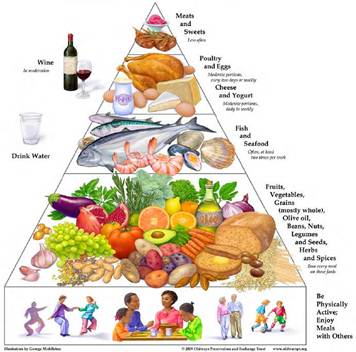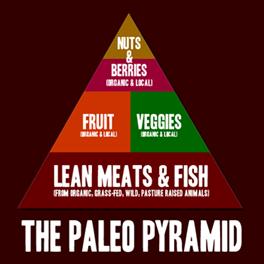

Popular Diets
Support for development of this module was provided by the New Balance foundation (C. Lenders [PI] and K. Gorman [coPI].
After successfully completing this module, you will be able to:
.
|
|
|
|
Over 33% of the adult US population is obese, and an additional 34% are considered overweight. Patients are often trying to lose weight, and it is estimated that Americans spend $33 billion dollars per year on products for weight-loss. Patients may fall prey to the newest fad diets, which often promise dramatic weight loss despite being largely untested.

It is important that patients know the truth about dieting, and that we are able to guide their choices.
Why do diets fail?
Sustainable weight loss is often the result of a lifestyle change and not a "diet" with a start and end date connected to it. A recent Consumer Report rated popular diet books and plans and provided common sense tips for sustainable weight loss: http://www.consumerreports.org/cro/food/diet-nutrition/diets/diets-6-07/overview/0607_diets_ov.htm. Teens who are tempted to lose weight by adopting one of the fad diets should read the information at this web site: http://www.youngwomenshealth.org/fad_diets.html.
Most popular diets fall into one of two categories: Low Carb/High Protein or High Carb/Low Fat diets.
| Low Carb/High Protein | High Carb/Low Fat |
|---|---|
|
- Emphasize protein intake - Restrict calories - Tend to be higher in fat
Examples: Atkins Protein Power The Zone |
- Emphasize carbohydrate intake - Tend to be higher in fiber and lower in fat
Examples: The Pritikin Diet Volumetrics DASH |
There are many fad diets. However, this learning module will focus on several of the more popular diets, which are listed here:
|
|
The Atkins Food Pyramid |
The Atkins diet is a low-carbohydrate diet. There is an initial induction phase during which the dieter may consume no more than 20 grams per day of net carbohydrates (total carbohydrates - fiber). After the two-week induction period, carbohydrates are gradually increased to 120 grams per day. With the Atkins diet, there are no restrictions on intake of calories, protein, or fat (except no trans fats).


These links may be helpful in figuring out the correct answer:
|
Pros |
Cons |
|---|---|
|
|
You can read more about the Atkins diet from the Mayo Clinic at http://www.mayoclinic.com/health/atkins-diet/MY00648/METHOD=print ..
|
|
|
The DASH diet was developed as a lifestyle intervention to lower blood pressure. It has the following major features:
|
Pros |
Cons |
|---|---|
|
None known |
More information on the DASH Diet can be found in this publication from the National Institutes of Health.


|
|
The Ornish Food Pyramid |
The Ornish Diet is a vegetarian diet designed to provide calories in the following ratio: 10% fat (very low), 20% protein, 70% carbs. There are no calorie restrictions, but it restricts simple carbohydrates (Alcohol, sugar, white flour). It eliminates cholesterol from the diet, because it is vegetarian.
|
Pros |
Cons |
|---|---|
|
|


At some point in your career, you may need to provide dietary counseling to a vegetarian or vegan. A 2008 survey conducted by Harris Interactive Survey Bureau determined that were 7.3 million vegetarians in the United States (3.2% of U.S. adults) and 1 million vegans (0.5% of U.S. adults). [Lacto-ovo vegetarians avoid all animal flesh, including fish, but they do eat eggs (ovo-) and milk (lacto-).]
Note the amount of dairy and sources of protein in the vegetarian and vegan food pyramids shown below.
|
Vegetarian Food Pyramid |
Vegan Food Pyramid |
|
Pros |
Cons |
|---|---|
|
|
These are also some common myths about vegetarianism:
Note that when children follow vegetarian diets, there are several special considerations.
You should also review the USDA Recommendations for Vegetarians.
In the "Quiz Me" below, match each of the three potential problems with a vegetarian to its most likely solutions.


The Mediterranean Diet emphasizes consumption of fruits, vegetables, whole grains, beans, nuts, legumes, olive oil, and flavorful herbs and spices. Eating fish and seafood several times a week is encouraged as well as enjoying poultry, eggs, cheese, and yogurt in moderation. Sweets and red meat should be reserved for special occasions. For more information see the Mayo Clinic's web pages on the Mediterranean Diet.

|
Pros |
Cons |
|---|---|
|
|
 The Paleolithic diet is also know as the "Paleo Diet", Caveman diet, Stone Age diet, and the Warrior diet. It emphasizes eating plants and wild animals similar to what hunter-gatherers may have eaten about 10,000 years ago. The diet consists mainly of fish, grass-fed pasture raised meats, vegetables, fruit, fungi, roots, and nuts. It excludes grains, legumes, dairy products, salt, refined sugar, and processed oils.
The Paleolithic diet is also know as the "Paleo Diet", Caveman diet, Stone Age diet, and the Warrior diet. It emphasizes eating plants and wild animals similar to what hunter-gatherers may have eaten about 10,000 years ago. The diet consists mainly of fish, grass-fed pasture raised meats, vegetables, fruit, fungi, roots, and nuts. It excludes grains, legumes, dairy products, salt, refined sugar, and processed oils.
The following resources also provide good summaries of the Paleo diet:
|
Pros |
Cons |
|---|---|
|
|
The Gluten-free diet is indicated for celiac disease (which may be accompanied by dermatitis herpetiformis) and wheat allergy. However, this diet has gained popularity in people without specific allergies to gluten. There have even been claims that this diet may help to treat autism, although this claim remains unproven. This diet excludes all gluten-containing products. Gluten is a protein found in wheat, barley, rye and titicale (hybrid mix of rye and wheat). Gluten is also an additive to many foods. In addition, while oats are gluten-free themselves, they are almost always contaminated by contact gluten-containing grains during processing.
|
Pros |
Cons |
|---|---|
|
|
There are many "gluten-free" products on the market that are modified versions of foods that naturally contain gluten, such as gluten-free breads and pastas. These foods are more expensive and calorically very similar to their gluten-containing counterparts.
A number of randomized clinical trials have compared weight loss after 6 months or a year after Low-carb diets vs. Low fat diets. At 6 months, there are differences in percent weight loss, with low-carb diets leading in percent loss. After one year, weight loss was similar between groups, but a low-carbohydrate diet was better with regard to dyslipidemia and glycemic control after adjustment for differences in weight loss.
The following table summarizes some of these studies.
|
Study |
Duration (months) |
% Wt. Loss Low-Carb |
% Wt Loss Low-Fat |
P Value |
|---|---|---|---|---|
|
Brehm J Clin Endo Metab 2003 |
6 |
-9.32 |
-4.22 |
<0.001 |
|
Samaha NEJM 2003 |
6 |
-4.46 |
-1.44 |
0.002 |
|
Yancy Ann int med 2004 |
6 |
-12.9 |
-6.7 |
<0.001 |
|
Foster NEJM 2003 |
6 |
-7.0 |
-3.2 |
0.02 |
|
12 |
-4.4 |
-2.5 |
0.26 NS |
|
|
Samaha Ann Int Med 2004 |
12 |
-3.9 |
-2.3 |
NS |
|
Truby BMJ 2006 |
6 |
-6.2 |
-7.3 |
<.001 |
|
Gardner JAMA 2007 (% BMI)* |
6 12 |
-2.16* -1.65* |
-0.85* -0.77* |
NS 0.01 |
|
Foster Ann Int Med 2010 |
12 24 |
-10.87 -6.34 |
-10.81 -7.37 |
0.95 NS 0.41 NS |
Sacks et al. conducted a randomized clinical trial among 811 overweight adults enrolled in 2-year study Subject were randomly assigned to one of 4 diets:
The authors summarized the results as follows:
"Among the 80% of participants who completed the trial, the average weight loss was 4 kg; 14 to 15% of the participants had a reduction of at least 10% of their initial body weight. Satiety, hunger, satisfaction with the diet, and attendance at group sessions were similar for all diets; attendance was strongly associated with weight loss (0.2 kg per session attended). The diets improved lipid-related risk factors and fasting insulin levels."
They concluded:
"Reduced-calorie diets result in clinically meaningful weight loss regardless of which macronutrients they emphasize."
Almost 20% of adolescents in the US are obese, and it is important to be able to advise them regarding dieting strategies that are safe and effective. Adolescents are particularly vulnerable to the advertising and false promises of popular diets. It is important to assess what and how your pediatric patients are eating, and encourage them to eat a wide variety of foods. Crash dieting, avoiding certain food groups, and disordered eating are particularly common among overweight, competitive athletes, and many young women. Nevertheless, small studies have shown that low-carbohydrate diets and energy-restricted low-fat diets have similar short-term weight management successes, and they are generally safe. However, there is very limited data on the long-term outcomes and safety of specific diets for children and adolescents. In adolescents, emphasis should be put on the following lifestyle changes that have been shown to be most effective:
For more information, consult the following resources:
Reduced-calorie diets resulted in clinically meaningful weight loss regardless of which macronutrients they emphasized:
Main Caveat: The mean reported intakes at 6 months and 2 years did NOT reach target levels for macronutrients
American Heart Association - No-Fad Diet tips: http://www.heart.org/HEARTORG/GettingHealthy/WeightManagement/No-Fad-Diet-Tips_UCM_305838_Article.jsp
The National Weight Control Registry (NWCR) over 5,000 registrants (80% women) who have provided information suggesting that those persons who are able to lose weight and keep it off consume low fat diets, reduce the number of calories consumed, and expend on average 400 kcal of physical activity on a daily basis.
Observations from the NWCR:
- 78% eat breakfast every day.
- 75% weigh themselves at least once a week.
- 62% watch less than 10 hours of TV per week.
- 90% exercise, on average, about 1 hour per day.
There are many variations on a successful program, but a successful program will likely have the following characteristics:

